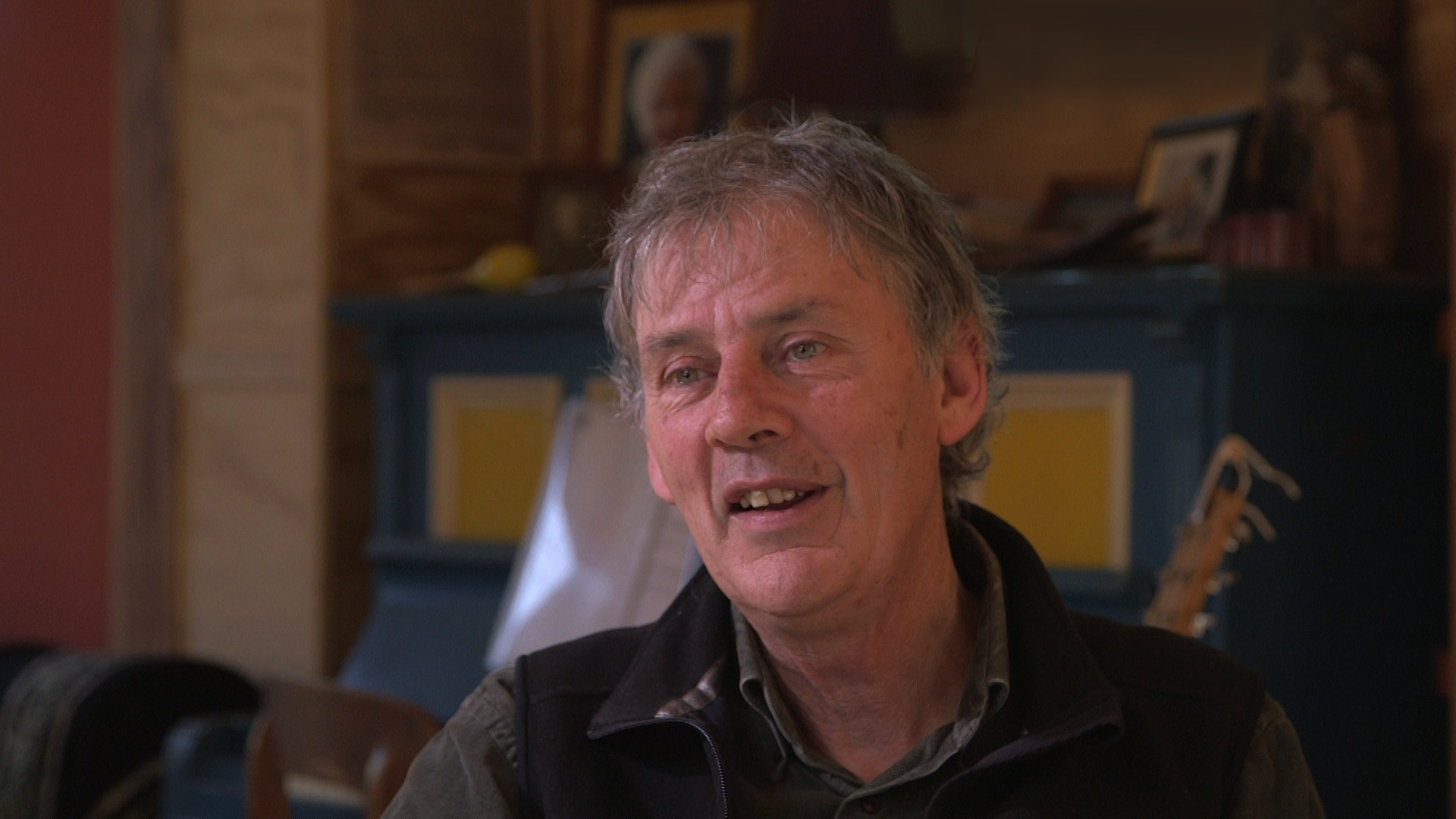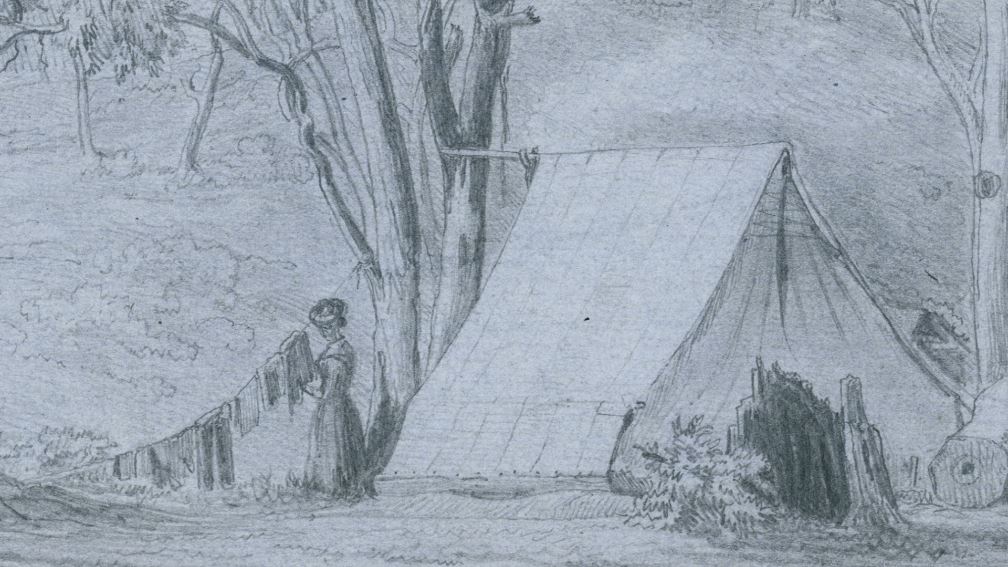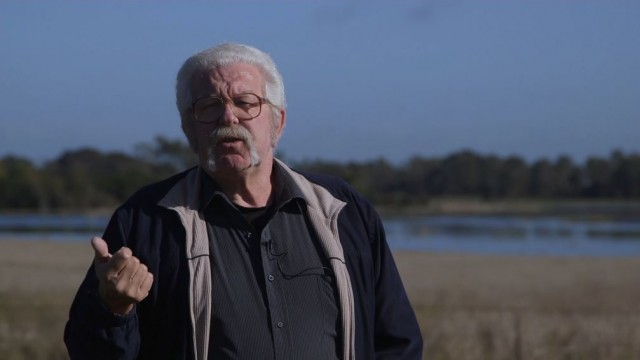Many Roads: Chinese on the Goldfields
Info
Commissioned by: Culture Victoria
Produced: 2017
Length: 11.35 minutes

Chinese people took many roads to get to the goldfields of Victoria in the 1850s. Image: Samuel Charles Brees, Flemington Melbourne, watercolour, ca 1856, courtesy of State Library of Victoria.

Chinese culture would influence Victoria in many unexpected ways. Image: Parade costume jacket (detail), silk, cotton, gold thread. China, c. 1880. Courtesy of the Golden Dragon Museum. Image by Jary Nemo.

Chinese miners faced discrimination which they resisted through petitions and other means. Image: Petition to Governor Barkly. PROV, VA 475 Chief Secretary’s Department, VPRS1189/P0, Inward Registered Correspondence, Unit 522, Item: 59/7364, Sub Item: B82/59. Courtesy of Public Record Office Victoria. Image by Jary Nemo.

The digital exhibition features video and audio interviews with historians and experts such as Anna Kyi, historian. Image by Jary Nemo.

The digital gallery features 100 images of engravings, maps, photographs, documents and artefacts. Image: Going to market, China [picture], John Henry Harvey, photographer, Thomas Allom, artist. 1 transparency : glass lantern slide. ca. 1900-1920. Courtesy of the State Library of Victoria.
The Story
In the 1850s tens of thousands of Chinese people flocked to Victoria, joining people from around the world who came here chasing the lure of gold. Fleeing violence, famine and poverty in their homeland they sought fortune for their families in the place they called ‘New Gold Mountain’. Facing discrimination and injustice they carved out lives in this strange new land.
The Chinese took many roads to the goldfields. They left markers, gardens, wells and place names, some which still remain in the landscape today. At the peak migration point of the late 1850s the Chinese made up one in five of the male population in fabled gold mining towns of Victoria such as Ballarat, Bendigo, Castlemaine, Beechworth and Ararat. It was not just miners who took the perilous journey. Doctors, gardeners, artisans and business people voyaged here and contributed to Victoria’s economy, health and cultural life.
Many Roads: Stories of the Chinese on the Goldfields of Victoria showcases the extent of the Chinese influence in the making of Victoria, which reaches farther back than many have realised.
Digital Exhibition
The all-digital project features an eleven minute film featuring curators, historians and Chinese Victorian descendants, two extended audio interviews and one extended video interview with key experts, a digital gallery featuring a hundred images of artefacts, documents, photographs and illustrations from museums, galleries and historical societies, and six essays written by Victorian historical experts. The story canvasses the discrimination the Chinese faced and the famous overland treks the Chinese were forced to take to get to Victoria, but also the various positive ways the Chinese contributed to the economy and culture of Victoria.
All items in the digital exhibition are free to watch, show and share from the link https://cv.vic.gov.au/stories/immigrants-and-emigrants/many-roads-stories-of-the-chinese-on-the-goldfields-of-victoria/ .
The project was commissioned by Culture Victoria, an online platform that shares the stories held by collecting organisations across the state. It was produced by Ballarat-based production company Wind & Sky Productions in collaboration with the Museum of Australian Democracy at Eureka, the Gold Museum- Sovereign Hill Museums Association, the Golden Dragon Museum Bendigo and the Gum San Chinese Heritage Centre Ararat.
The Film
The story’s 11 minute documentary film explores the story of Chinese people in the Victorian gold rush, uncovering the routes the Chinese took to seek gold, the lives they lived and the sort of people they were.
The film contains beautiful montages of archival images, illustrations and photographs from Victoria’s regional collections. It features interviews with Cash Brown, Curator and Conservator at the Museum of Australian Democracy at Eureka, Anita Jack, General Manager of the Golden Dragon Museum and great grand daughter of a goldrush-era Chinese migrant, Professor Keir Reeves, Director, Collaborative Research Centre in Australian History, Federation University Australia, and Heather Ah Pee, Former Coordinator, Gum San Chinese Heritage Centre and related by marriage to a goldrush era Chinese forebear.
An extended video feature includes a full interview with historian Anna Kyi on attitudes towards Chinese migration from the 19th century to the present, harmony and conflict on the goldfields and the complexity of the Eureka story.
Awards and Nominations
Highly Commended, Communicating, promoting and celebrating heritage, 2019 Ballarat Heritage Design and Excellence Awards
Credits
- Creative Producers:
- Lucinda Horrocks and Jary Nemo
- Commissioning Editors on behalf of Culture Victoria:
- Eleanor Whitworth and Dimity Mapstone
- Production Company:
- Wind & Sky Productions
- Project Manager:
- Jary Nemo
- Digital Gallery Curator:
- Lucinda Horrocks
- Film Director:
- Jary Nemo
- Interviewees:
- Heather Ahpee, Cash Brown, Anita Jack, Anna Kyi and Keir Reeves
- Essay Contributors:
- Cash Brown, Fred Cahir, Ian Clark, Liz Denny, Anna Kyi and Benjamin Mountford
- Research Advisors:
- Cash Brown, Fred Cahir, Snjezana Cosic, Liz Denny, Yvonne Horsfield, Anna Kyi, Elizabeth Marsden, Leigh McKinnon, Benjamin Mountford, Rick Mitchell, Diann Talbot, John Tully and Charles Zhang
- Produced in collaboration with:
- the Museum of Australian Democracy at Eureka, the Gold Museum- Sovereign Hill Museums Association, the Golden Dragon Museum and the Gum San Chinese Heritage Centre
- Contributing Organisations:
- Art Gallery of Ballarat, Bendigo Chinese Association, Bright and District Historical Society, Chinese Museum, Creswick Museum, Dunolly Museum, Golden Dragon Museum, Gum San Chinese Heritage Centre, Library of Congress, Museum of Australian Democracy at Eureka, Museums Victoria, Myrtleford and District Historical Society, National Library of Australia, Newstead Historical Society, Public Record Office Victoria, Sovereign Hill Museums Association and State Library of Victoria
- Camera, Sound, Editing and Post Production by:
- Jary Nemo
- Story Research, Interviews and Digital Gallery Content Written by:
- Lucinda Horrocks
- Additional Digital Gallery Content Written by:
- Cash Brown, Liz Denny and Yvonne Horsfield
- Digital Content Upload and Assistance:
- Sharon Turley
- Content Management System Co-Ordinator:
- Dimity Mapstone
- With Thanks to:
- Kay Adams, Lauren Bourke, Sam Brown, Fred Cahir, Angela Campbell, Ian Clark, Snjezana Cosic, Jan Croggon, Kate Dunn, Andrew Evans, Peter Freund, Margaret Fullwood, Luke Grimes, Henry Gunstone, Yvonne Horsfield, Sam Henson, Jemma Holcombe, David Hood, Bill Horrocks, Heather Horrocks, Julie Kilpatrick, Elizabeth Liddle, Hong Lim, Geoffrey Lord, Lucy Lv, Samantha Mackley, Elizabeth Marsden, Sarah Masters, Pauline McCall, John McDonald, Moya MacFadzean, Kathryn McKenzie, Julie McLaren, Gordon Morrison, Bill Moy, Jim Oastler, Philippa O’Halloran, Dennis O’Hoy, Michelle Philips, Anne Rowland, Padmini Sebastian, Kylee Smith, Jane Smith, Michelle Smith, Diann Talbot, John Taylor, John Tully, Sharon Turley, Mindy Meng Wang, John Watson, the Chinese Australian Cultural Society Ballarat, the Chinese Community Council of Australia Victoria, the Bendigo Chinese Association, the Bright and District Historical Society, the Myrtleford and District Historical Society, the Ballarat Historical Society, Ararat City Council, Ballarat City Council, Bendigo City Council, Federation University Australia, La Trobe University, the Art Gallery of Ballarat, Creswick Museum, Dunolly Museum, Museums Victoria and Public Record Office Victoria
- Film Shot on Location at:
- Museum of Australian Democracy at Eureka, Ballarat, Golden Dragon Museum, Bendigo, Gold Museum and Sovereign Hill, Ballarat, Wind & Sky Productions Studio, Ballarat
- Acknowledgements:
- This project was created for Culture Victoria with the support of the Victorian Government through Creative Victoria. Project production and development took place on the traditional lands of the Wadawurrung, Djab Wurrung and Dja Dja Wurrung peoples. We would like to acknowledge these traditional owners and pay our respects to their Elders, past and present.
- Copyright with:
- Wind & Sky Productions ©2017 unless otherwise acknowledged.
The Howard Family – M.A.D.E Digital Stories
Info
Client: Museum of Australian Democracy at Eureka
Produced: 2014
Length: 4.07 minutes
Ella Hancock is 98 years old and she is one degree of separation from Eureka. Her grandfather Patrick Howard fought in the stockade. Patrick Howard was arrested after the uprising, but escaped trial because his gun wasn’t loaded. Celebrated musician Shane Howard is Patrick Howard’s great-grandson. In this short film Shane and Ella reflect on Patrick’s involvement at the Stockade, the factors which drove Patrick to migrate from Ireland and fight for his rights on the Ballarat goldfields, and they discuss the legacy of the Eureka Stockade today.
Wind & Sky Productions produced four short digital stories for the Museum of Australian Democracy at Eureka as part of the commemoration of the 160th Anniversary of the Eureka Stockade. The films are on permanent display in the Museum touchtable exhibition.
Screenings
On permanent display, Museum of Australian Democracy at Eureka, Ballarat.
Credits
- Produced by:
- Jary Nemo and Lucinda Horrocks
- Production Company:
- Wind & Sky Productions
- Directed and edited by:
- Jary Nemo
- Written and researched by:
- Lucinda Horrocks
- Featuring:
- Ella Hancock and Shane Howard
- Camera and Sound:
- Jary Nemo
- Interviews:
- Lucinda Horrocks
- Archival images courtesy of:
- Ballarat and District Irish Club, Ella Hancock, J J Harrison, Gold Museum, Ballarat, John Oxley Library, State Library of Queensland, The Public Records Office of Victoria, The State Library of Victoria.
- With thanks to:
- Catriona Banks, Clare Gervasoni, Adele Howard, Clair Muir and Teresa O’Brien.
- Commissioned by:
- Jane Smith, Museum of Australian Democracy at Eureka.
- Funded by:
- Victorian Department of Premier and Cabinet.
- Acknowledgement:
- We give thanks to the Wathaurung people of the Kulin Nation, the traditional owners of the land where the Eureka Stockade took place, and pay respect to their Elders past and present.
- Copyright with:
- © M.A.D.E. Ballarat 2014. All rights reserved.
Val D’Angri – M.A.D.E Digital Stories
Info
Client: Museum of Australian Democracy at Eureka
Produced: 2014
Length: 4.32 minutes
In late 1972 high school sewing teacher Val D’Angri was asked to hand stitch the Eureka Flag onto a custom built backing. She undertook the labour intensive restoration work over a two week period in May 1973 in the Oddie Gallery, at the Art Gallery of Ballarat (then known as the Ballarat Fine Art Gallery). In this short film Val recalls what she felt on seeing the flag for the first time, her emotions on touching and restoring the flag, and the hours of back breaking work it took to finish the project. Val argues that the way the flag was constructed points to women having made it. She speculates what life must have been like for those rebellious women in the Spring of Eureka, November 1854.
Wind & Sky Productions produced four short digital stories for the Museum of Australian Democracy at Eureka as part of the commemoration of the 160th Anniversary of the Eureka Stockade. The films are on permanent display in the Museum touchtable exhibition.
Screenings
On permanent display, Museum of Australian Democracy at Eureka, Ballarat.
Credits
- Produced by:
- Jary Nemo and Lucinda Horrocks
- Production Company:
- Wind & Sky Productions
- Directed and edited by:
- Jary Nemo
- Written and researched by:
- Lucinda Horrocks
- Featuring:
- Val D’Angri
- Camera and Sound:
- Jary Nemo
- Interviews:
- Lucinda Horrocks
- Artwork:
- ‘The Three Gums’ © Hans Heysen/Licensed by Viscopy, 2014
- Archival images courtesy of:
- Ballarat City Council, Ballarat Historical Society, The Art Gallery of Ballarat, The Ballarat Courier, The Gold Museum, Ballarat, The National Library of Australia, The State Library of Victoria, Val and Norm D’Angri.
- With thanks to:
- Anne Beggs-Sunter, Norm D’Angri, Rita Cousens, Ursula Diamond-Keith, Andrew Eales, Edith Fry, Peter Freund, Claire Gervasoni, Merrilyn Harlock, Julie McLaren, Gordon Morrison, Claire Muir, Leslee Sullivan, Val Stevens and the Art Gallery of Ballarat.
- Commissioned by:
- Jane Smith, Museum of Australian Democracy at Eureka.
- Funded by:
- Victorian Department of Premier and Cabinet.
- Acknowledgement:
- We give thanks to the Wathaurung people of the Kulin Nation, the traditional owners of the land where the Eureka Stockade took place, and pay respect to their Elders past and present.
- Copyright with:
- © M.A.D.E. Ballarat 2014. All rights reserved.
Uncle Bryon Powell – M.A.D.E Digital Stories
Info
Client: Museum of Australian Democracy at Eureka
Produced: 2014
Length: 4.07 minutes
Uncle Bryon Powell is a Wathaurung Elder. His family can trace its descent to the traditional owners of the land around the Ballarat region. At Wathaurung Corporation, Uncle Bryon maintains links with Ballarat’s Indigenous past and culture through ceremony, education and consultation. The story of Indigenous people during the time of Eureka has not been told, argues Uncle Bryon. In this film Uncle Bryon introduces the undisturbed location of Winter’s Swamp, near Ballarat, which contains remnants of Indigenous inhabitation going back hundreds, perhaps thousands of years. He talks about what life was like for Indigenous people before colonisation and details the resilience and adaptability of Wathaurung people on the goldfields in the face of the challenge to their culture and the transformation of their land.
Wind & Sky Productions produced four short digital stories for the Museum of Australian Democracy at Eureka as part of the commemoration of the 160th Anniversary of the Eureka Stockade. The films are on permanent display in the Museum touchtable exhibition.
Screenings
On permanent display, Museum of Australian Democracy at Eureka, Ballarat.
21 November 2015, Castlemaine Local and International Film Festival (CLIFF)
Credits
- Produced by:
- Jary Nemo and Lucinda Horrocks
- Production Company:
- Wind & Sky Productions
- Directed and edited by:
- Jary Nemo
- Written and researched by:
- Lucinda Horrocks
- Featuring:
- Uncle Bryon Powell
- Camera and Sound:
- Jary Nemo
- Interviews:
- Lucinda Horrocks
- Archival images courtesy of:
- The Gold Museum, Ballarat, The State Library of Victoria, The National Gallery of Victoria, The W.L. Crowther Library, Tasmanian Archive and Heritage Office.
- With thanks to:
- Adrian Burrow, Fred Cahir, Ian Clark, Gary Presland, Claire Muir, Hedley Thomson, the Ballarat Environment Network (BEN), the Department of Environment and Primary Industries (DEPI), and the Wathaurung Aboriginal Corporation.
- Commissioned by:
- Jane Smith, Museum of Australian Democracy at Eureka.
- Funded by:
- Victorian Department of Premier and Cabinet.
- Acknowledgement:
- We give thanks to the Wathaurung people of the Kulin Nation, the traditional owners of the land where the Eureka Stockade took place, and pay respect to their Elders past and present.
- Copyright with:
- © M.A.D.E. Ballarat 2014. All rights reserved.
The Blog
- All (94)
- Commissioning Advice (3)
- Events (24)
- Image Galleries (3)
- Media Releases (12)
- Project Stories (16)
- Welcome (1)
- Wind & Sky Digest (44)
What's New
‘The Missing’ wins Best Short Documentary Award in Zurich
‘The Missing’ has won the ‘Best Short Documentary’ award at the Inspirational Film Festival in Zurich.
Lucinda Horrocks writes ‘Discovering an Archive’
Wind & Sky Producer Lucinda Horrocks has written an article for Provenance Journal.
‘The Missing’ nominated for awards in Berlin, Tokyo and Hawaii
‘The Missing’ has been nominated for several global awards
‘The Missing’ Nominated in British Short Film Awards
‘The Missing’ has been nominated for an award at the British Short Film Awards.
 Wind & Sky Productions
Wind & Sky Productions

















